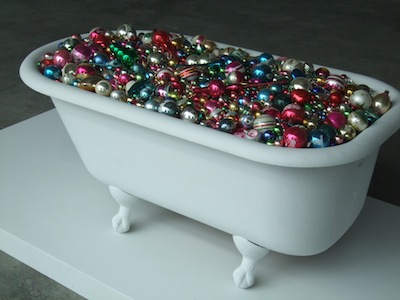
Hoarding Is Subject of Objectophilia: Artist Lauri Lynnxe Murphy exhibits and curates
Excess can also be found across the street from MCA Denver in the smaller of two venues that play host to Objectophilia, a primarily local artist exhibit curated by Denver artist Lauri Lynnxe Murphy. In what has become her swan song to Denver, Murphy conceptualized this exhibit during the early days of Biennial planning when Bruce Mau was still involved. Her concept was to create a show that was a reaction to Energy Effects. She knew she was going to call it Objectophilia and focus on our societies addiction to stuff. Throughout the process she also decided to apply to graduate school and will be leaving for Ohio State in a few short weeks. Objectophilia became a personal mantra, an exhibit about hoarders and her moving and how would she take all the stuff she had collected over the years. She realized for herself that she had an emotional attachment to odd things like a shoe horn she found in her desk.

Luo Brothers, "Welcome! Welcome! 5/8 (Baby with Koi), 2008, Fiberglass, Courtesy Robischon Gallery
Murphy expended an immense amount of energy putting together something for essentially no purpose. Her own curatorial work of “art.” The exhibit in the smaller 4,000 square foot space is tighter and more controlled than the 17,000 square foot ground floor of a nearby high rise. Murphy selected 45 artists for the show including a few from outside of Colorado like Sarah Applebaum, Portia Munson, David Buckingham, Holly Fisher, Jud Turner, Tuscany Wenger, and Chris Purdie whose “Spine” made from lamps and extension cords fills a corner creating an illuminated creature. Dave Sellers “Death Squad” and “Commander-in-Chief” is the artists version of Toy Story 3, featuring plastic soldiers with “DIE YOU,” “DIRTY,” and “FUCKIN ARTIST” banners falling from their guns like in old cartoons. The Commanders response? “SHUT UP & BUY.” The work that should be in Energy Effects is Jimmy Descants “The Baker Happier Hunting Grounds Deluxe Rocketship,” a found object assemblage as aesthetically sleek as Sanborns “Terrestrial Physics.”

Chris Purdie, "Spine," 2010, Lamps & Extension Cords
Unfortunately Murphy didnt have enough time to find works to fill the larger space, or the money to block off the unused portion, so the exhibit has less tension, conflict and dynamic. That said, some of my favorite pieces are exhibited in the second space such as Terry Makers “Reptilius Consumerus Devourus” a giant paper mache snake made from money, checks and brown kraft paper sliced up like bread. Jon Reitfors “View of Sky and Clouds with Disposable Coffee Cups” features a resin print of blue sky and puffy clouds in the base and interior of white paper cups. Im a big fan of Portia Munson and loved that Murphy displayed her C-Print “Pink Project: Table, from the exhibition Bad Girls, New Museum, 1994″ with paper clips. Jerry Kunkels paintings of trash and litter on the streets are exquisitely rendered and beautiful in their own way and Phil Benders “Bathtub with Christmas Ornaments” speaks well to the boxes stored in my attic taken out for one holiday a year. And Tuscany Wenger of Santa Fe creates these packaged found objects that are indicative of the energy we waste consuming items.

Portia Muson, "Knitting #18," 2010 Yarn and Musclemen
The title of this exhibition comes from the psychic condition known as paraphilia, a little known disorder in which people fall in love with objects and actually believe it is reciprocal.
Objectophilia and Energy Effects both stand on their own. Other than whats been mentioned I dont see much that links or reacts between the two exhibits. And thats fine. Gonzala Lebrija was commissioned to recreate his photograph “Entre La Vida y La Muerte” into a sculpture that sits in the parking lot between MCA and the smaller Objectophilia venue. “History of Suspended Time: Monument for the Impossible,” could symbolize both exhibits. Murphy had little time (less than 2 1/2 months) and a mere $14,000 budget to pull together Objectophilia. But she did it and it works. While Energy Effects may not be able to capture the pure moment of creation and suspend it in time, it goes farther than any other exhibit that is part of the Biennial of the Americas to pushing the boundaries of what we consider “art.”
(top photo: Phil Bender, “Bathtub with Christmas Ornaments,” 2010, Found Objects)
